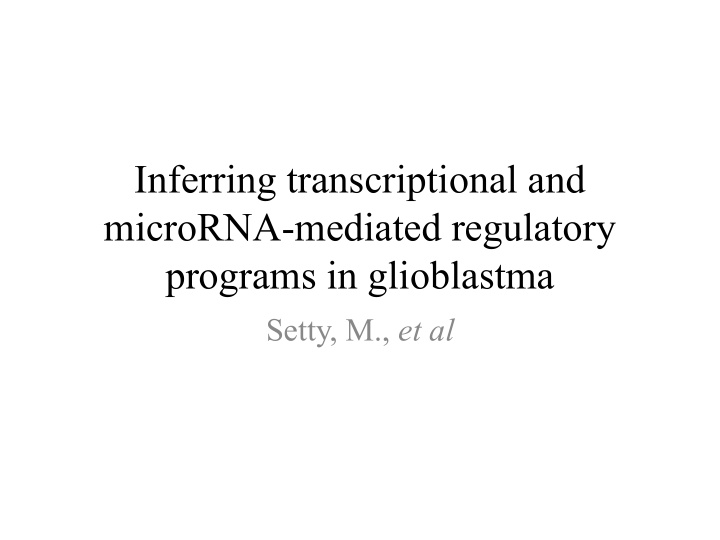



Inferring transcriptional and microRNA-mediated regulatory programs in glioblastma Setty, M., et al
Goal • Integrate multiple layers of data for tumor – DNA copy number, promoter methylation, mRNA expression, and miRNA expression. • Understand the role of miRNA-mediated and transcription factors (TFs) regulation. • Characterize the pattern of dysregulation in tumors in terms of TFs and miRNAs
Glioblastoma muliforme (GBM) • Four expression-based subtypes – Proneural Classical Mesenchymal Neural
miRNA Regulation
DNA methylation DNA methylation is a biochemical process where a methyl group is added to the cytosine or adenine DNA nucleotides.
Why Important to Study miRNA Regulation? • Impairment of the miRNA regulatory network is viewed as a key mechanism of glioblastma pathogenesis. • miRNA expression signatures have been used to classify GBM into subtypes related to lineages in the nervous system • miR-26a has been shown to promote gliomagenesis in vivo by repression of the tumor suppressor PTEN.
Scheme • Combine mRNA, copy number and miRNA profiles with regulatory sequence information • Learn the key direct regulators – TFs and miRNAs using promoter and 3’UTR motif features with sparse regression
Method-outline
Target prediction for TFs and miRNAs • Determine TFs binding site using DnaseI HS Sequencing • Determine miRNA binding sites using 7-mer seed matches in the 3’UTR of the Refseq genes.
From Lecture of Jan 22 nd by Prof. Gitter Transcriptional regulation • ChIP-seq directly measures transcription factor (TF) binding but requires a matching antibody • Various indirect strategies Wang2012
From Lecture of Jan 22 nd by Prof. Gitter Predicting regulator binding sites • Motifs are signatures of the DNA sequence recognized by a TF • TFs block DNA cleavage • Combining accessible DNA and DNA motifs produces binding predictions for hundreds of TFs Neph2012
Regression model to predict log gene expression changes • Counts of TF and miRNA binding sites • An estimate of gene’s average copy number • Promoter DNA methylation
Lasso regression models • To avoid overfitting • Use lasso constraint to identify a small number of TFs and miRNA
Joint Learning with Group Lasso
Sparse Regression Models Predict Differential of Subtypes of Tumor Samples
Dependency analysis • To determine regulators (TFs and miRNAs) that significantly account for common and subtype-specific gene expression changes.
Results - Feature Analysis of Group Models Identifies Common and Subtype Specific Regulators
• Thanks for your attention !
Recommend
More recommend